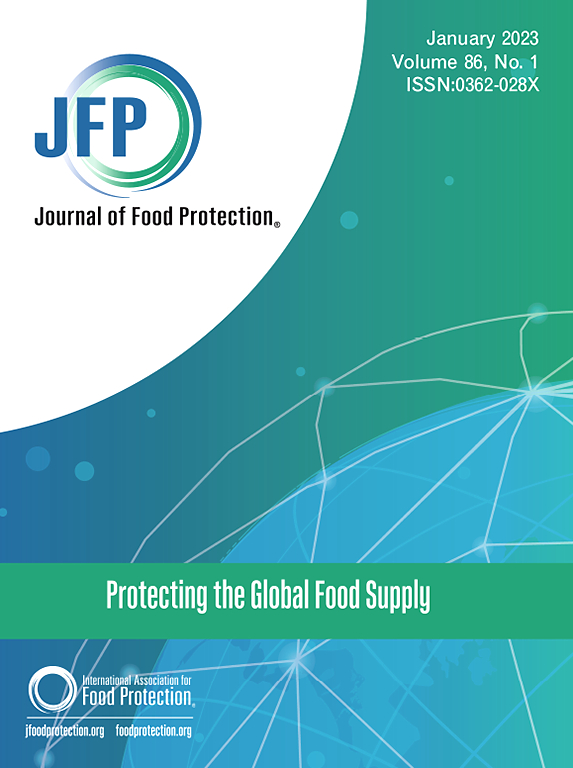Impact of Storage Conditions on Salmonella enterica and Listeria monocytogenes in Pre- and Post-Printed 3D Food Ink
IF 2.1
4区 农林科学
Q3 BIOTECHNOLOGY & APPLIED MICROBIOLOGY
引用次数: 0
Abstract
3D food printers (3DFPs) allow for the customization of physicochemical properties of foods in new ways. Storage conditions for food ink capsules and printed food inks have not been investigated. This study aimed to determine the impact of storage temperature, time, and method (pre- vs. postprinting) on Salmonella enterica and Listeria monocytogenes. A bacterial cocktail was cultured in minimal media and added to a protein cookie food ink at ∼6.5 log CFU/g. The inoculated food ink was divided into 18 capsules (50 g/capsule); half were 3D printed. The remaining capsules and printed products were stored at three temperatures [20 °C, 4 °C, −18 °C]. Selective media (XLT-4 and CHROMagar Listeria) were used for pathogen enumeration. Aerobic plate count and yeast counts were performed at each time point. The pH and water activity (aw) of the food ink were measured at the initial and final timepoints. A significant four-way interaction effect was observed between microorganism type (L. monocytogenes/Salmonella), time, temperature, and storage method (capsule/print) (p = 0.014). Significant findings include (1) at −18 °C, concentrations of L. monocytogenes decreased between Day 0 and Day 1, (2) at 20 °C, concentrations of S. enterica were significantly higher in the capsule than in the printed food on Day 1 (p < 0.0001), and (3) at 4 °C, concentrations of S. enterica were significantly higher in the printed food on Day 5 compared to Day 1 (p < 0.0001) with a 0.9 (95% CI: 0.89, 0.91) log increase. In addition, a significant three-way interaction effect was found between microorganism type (yeast/aerobic counts), time, and temperature (p = 0.024). Yeast counts remained steady at all temperatures, while aerobic counts increased at 4 °C. Minimal differences were observed between Listeria and Salmonella and their responses to varying storage conditions over time indicating that storage method and temperature may be less important for a low-water activity product such as protein cookie food ink.
储存条件对打印前和打印后三维食品油墨中肠炎沙门氏菌和单核细胞增生李斯特菌的影响。
三维食品打印机(3DFP)能够以全新的方式定制食品的理化特性。目前尚未对食品油墨胶囊和打印食品油墨的储存条件进行调查。本研究旨在确定储存温度、时间和方法(打印前与打印后)对肠炎沙门氏菌和单核细胞增生李斯特菌的影响。在最低限度的培养基中培养出鸡尾酒细菌,并以 ∼6.5 log CFU/g 的浓度添加到蛋白饼干食品油墨中。接种的食品油墨被分成 18 粒胶囊(50 克/粒),其中一半进行了 3D 打印。其余胶囊和打印产品分别储存在三个温度下[20°C、4°C、-18°C]。病原体计数使用选择性培养基(XLT-4 和 CHROMagar 李斯特菌)。在每个时间点进行需氧平板计数和酵母计数。在最初和最后的时间点测量食品油墨的 pH 值和水活性(aw)。微生物类型(单核细胞增生性酵母菌/沙门氏菌)、时间、温度和储存方法(胶囊/印刷)之间存在明显的四向交互效应(p=0.014)。重要发现包括(1) 在零下 18 摄氏度时,第 0 天和第 1 天之间单核细胞增多症杆菌的浓度下降;(2) 在 20 摄氏度时,第 1 天胶囊食品中肠炎沙门氏菌的浓度显著高于印刷食品(p=0.014)。
本文章由计算机程序翻译,如有差异,请以英文原文为准。
求助全文
约1分钟内获得全文
求助全文
来源期刊

Journal of food protection
工程技术-生物工程与应用微生物
CiteScore
4.20
自引率
5.00%
发文量
296
审稿时长
2.5 months
期刊介绍:
The Journal of Food Protection® (JFP) is an international, monthly scientific journal in the English language published by the International Association for Food Protection (IAFP). JFP publishes research and review articles on all aspects of food protection and safety. Major emphases of JFP are placed on studies dealing with:
Tracking, detecting (including traditional, molecular, and real-time), inactivating, and controlling food-related hazards, including microorganisms (including antibiotic resistance), microbial (mycotoxins, seafood toxins) and non-microbial toxins (heavy metals, pesticides, veterinary drug residues, migrants from food packaging, and processing contaminants), allergens and pests (insects, rodents) in human food, pet food and animal feed throughout the food chain;
Microbiological food quality and traditional/novel methods to assay microbiological food quality;
Prevention of food-related hazards and food spoilage through food preservatives and thermal/non-thermal processes, including process validation;
Food fermentations and food-related probiotics;
Safe food handling practices during pre-harvest, harvest, post-harvest, distribution and consumption, including food safety education for retailers, foodservice, and consumers;
Risk assessments for food-related hazards;
Economic impact of food-related hazards, foodborne illness, food loss, food spoilage, and adulterated foods;
Food fraud, food authentication, food defense, and foodborne disease outbreak investigations.
 求助内容:
求助内容: 应助结果提醒方式:
应助结果提醒方式:


